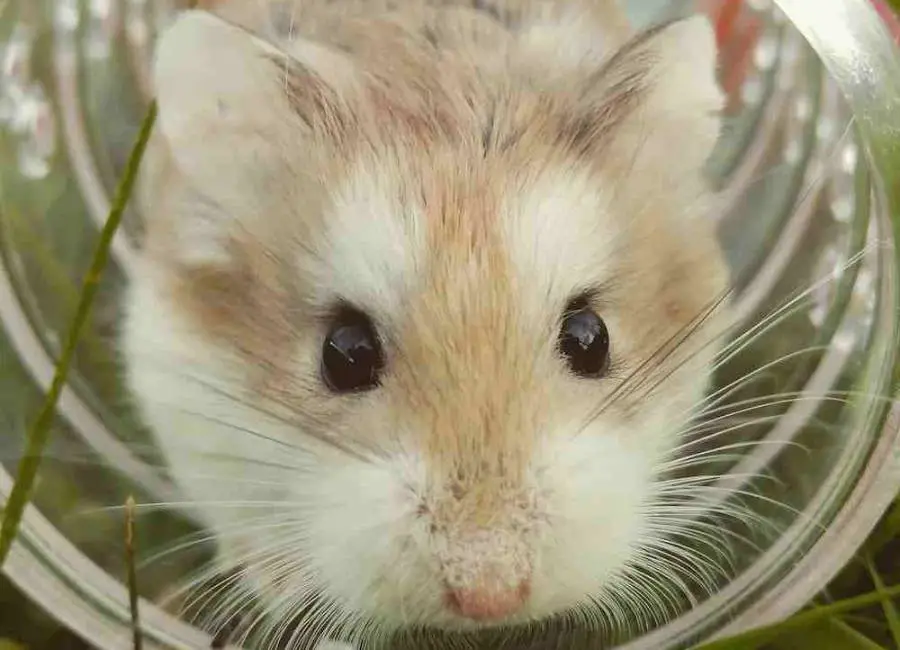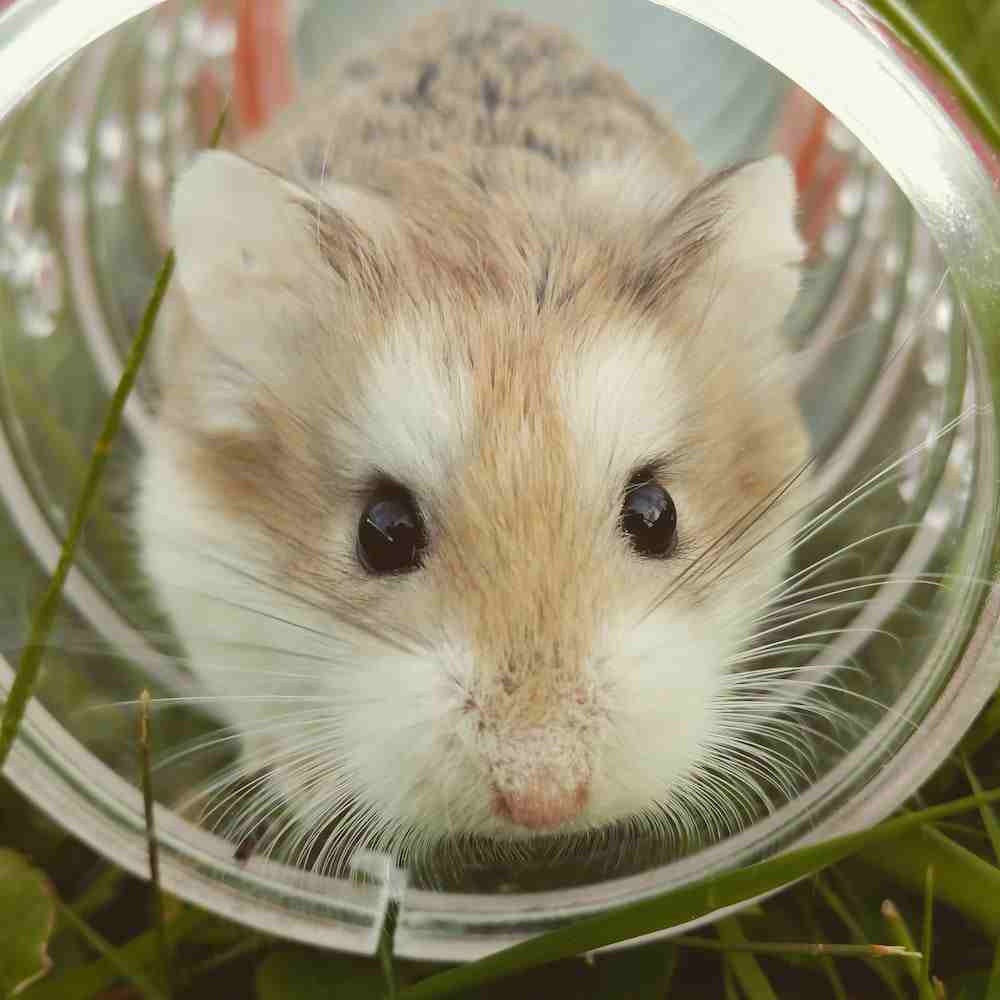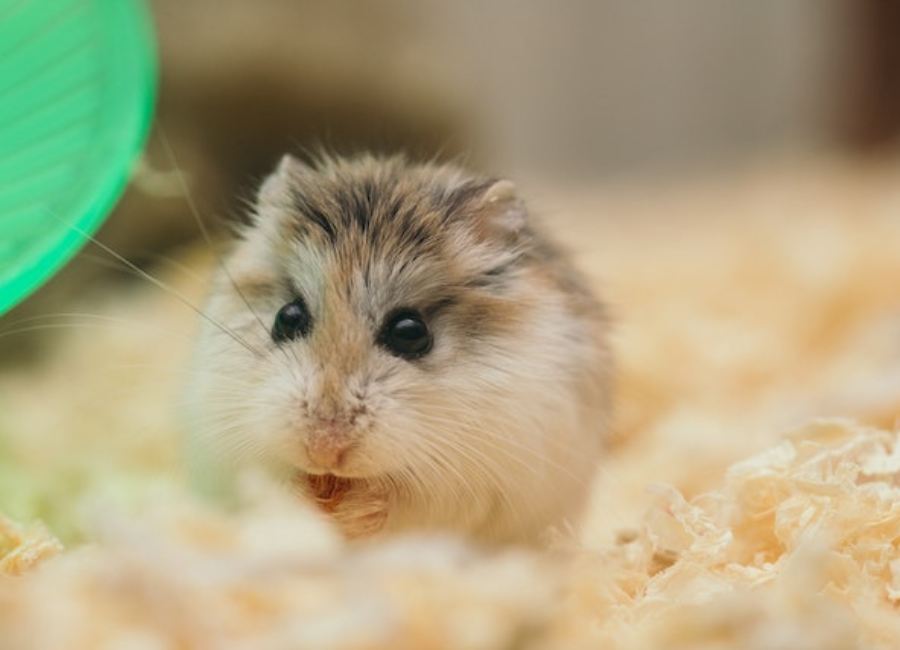8 Most Common Hamster Eye Problems & Tips

Hamsters are undoubtedly one of the cutest little critters around, with their adorable fluffy faces and tiny paws. But just like any animal, they can experience health issues from time to time.
One area that may need extra attention is their eyes – after all, those little orbs are their windows to the world!
In this post, we’re going to explore some common hamster eye problems you might encounter, and what you can do to prevent and treat them.
Signs of hamster eye problems
Hamsters can develop several eye problems that can cause discomfort, pain, and even vision loss.
Here are some of the most common signs of hamster eye problems:
- Redness: If you notice your hamster’s eyes are red, it could be a sign of inflammation.
- Excessive tearing: If your hamster’s eyes are watery and they are producing more tears than usual, it could be a sign of an infection.
- Discharge: If you see any discharge or crust around the eyes, it could indicate an infection or injury.
- Cloudiness: If your hamster’s eyes appear cloudy or hazy, it could be a sign of cataracts or corneal damage.
- Inability to open or close their eyes: If your hamster seems to be having trouble opening or closing their eyes, it could be a sign of an injury or infection.
- Rubbing or scratching of the eyes: If your hamster is frequently rubbing or scratching their eyes, it could indicate an irritation or injury.
- Swelling: If your hamster’s eyes appear swollen or bulging, it could be a sign of an infection or tumor.
- Sensitivity to light: If your hamster is squinting or seems to be avoiding light, it could be a sign of an injury or infection.
- Changes in behavior: Your hamster may exhibit changes in behavior if they are experiencing eye pain or discomfort. They may be less active or more irritable than normal.
If you notice any of these signs, it is important to take your hamster to a veterinarian who specializes in small animals as soon as possible.
Hamster eye problems can worsen rapidly if left unaddressed, and can even lead to vision loss or other health problems.
Learn more about illness in hamsters.
Common Hamster Eye Problems

Here are some of the most common hamster eye problems:
1. Conjunctivitis
Conjunctivitis in hamsters is one of the most common eye problems in hamsters. It is an inflammation of the conjunctiva, the clear membrane that covers the white part of the eye.
Conjunctivitis in hamsters can be caused by a variety of factors including bacteria or viruses, allergens, irritants, or even poor husbandry conditions.
The signs of conjunctivitis in hamsters include redness, swelling, discharge, and squinting or closing the eye.
Prevention of hamster conjunctivitis involves providing clean living conditions, avoiding dusty or irritant bedding, and minimizing stress.
Treatment usually involves cleaning the affected eye with saline or a similar solution, and administering eye drops or ointments prescribed by a veterinarian.
In severe cases, oral antibiotics may also be necessary. Proper care and early detection can help prevent complications and improve the chances of a successful outcome.
2. Proptosis
Proptosis or eye bulging is a common eye problem seen in hamsters. It occurs when the eye is pushed out of its socket due to injury or infection. The most common cause of proptosis in hamsters is trauma, such as fighting or rough handling.
Signs of proptosis in hamsters include one or both eyes bulging out of their sockets, redness, and swelling around the eye. To prevent proptosis, hamsters should be handled gently and housed in a safe and appropriate enclosure.
If a hamster is diagnosed with proptosis, the underlying cause should be treated, which may involve antibiotics, anti-inflammatory medication, or surgery. It is important to seek veterinary care as soon as possible to prevent further damage to the eye.
3. Corneal ulcer
Corneal ulcer is one of the most common eye problems in hamsters. It is a painful condition that affects the cornea, the transparent outer layer of the eye. Corneal ulcers in hamsters can be caused by a variety of factors, including injury, infection, or underlying diseases.
Signs of corneal ulcer include redness, discharge, squinting, and sometimes a bulging eye. Prevention of corneal ulcer in hamsters includes keeping their environment clean and free from sharp objects or potential injury sources.
Treatment options include antibiotic eye drops or ointments, pain relief medications, and in severe cases, surgery may be necessary. It’s essential to seek veterinary care promptly if you suspect your hamster has a corneal ulcer to prevent any further complications.
4. Cataracts
Cataracts in hamsters is a common eye problem that can cause cloudiness in one or both eyes of a hamster. It is common in older hamsters, but can also affect younger ones.
Cataracts can be caused by genetics, old age, disease, or trauma. Signs of cataracts include cloudiness in the eye, a loss of vision, and difficulty with movement.
There is no known prevention for cataracts in hamsters, but a balanced diet and clean living conditions can help in minimizing the risk.
Treatment for cataracts in hamsters typically involves surgical removal, although this can be risky for older hamsters. It is important to consult with a veterinarian if you suspect your hamster is suffering from cataracts or any other eye problem.
5. Abscesses
Abscesses in the eye are one of the common eye problems in hamsters. They are usually caused by bacterial infections and can occur from various causes such as injuries, scratches, or bites.
The signs of abscesses in hamster eye include swelling, redness, bulging, and discharge from the eye. Prevention methods may include keeping the hamster’s cage clean, avoiding overcrowding of hamsters, and avoiding fights between hamsters.
Treatment may involve draining the abscess, cleaning the eye, medication such as antibiotics, pain relief medication, anti-inflammatory medication, and other treatments prescribed by a veterinarian.
It is important to consult with a veterinarian as soon as any signs of abscesses in the eye are detected, as immediate treatment is crucial to prevent further complications.
6. Entropion
Entropion is a common eye problem in hamsters that causes the eyelid to turn inward. This is more prevalent among Syrian and dwarf breeds that have a rex curly haired coat.
Entropion can cause discomfort, irritation, and even damage to the cornea. The most common symptoms of entropion are sticky or crusty eyes, excessive tearing, squinting, and redness.
Preventing entropion in hamsters involves proper grooming and hygiene practices, as well as avoiding breeding hamsters that are known to have curly hair, as this trait is often associated with entropion.
If your hamster is diagnosed with entropion, treatment usually involves surgical correction of the affected eyelid. This may involve removing a small segment of the eyelid or repositioning the eyelashes.
Regular follow-up visits to your veterinarian are recommended to monitor the healing process and ensure that the condition does not recur. Overall, early detection and proper treatment are crucial in managing entropion and preventing its complications.
7. Glaucoma
Glaucoma is a common eye problem in hamsters that occurs as a result of increased pressure within the eye. This increased pressure can damage the optic nerve, which can lead to blindness if it goes untreated.
The signs of glaucoma in hamsters include a bulging eye, cloudiness in the eye, and redness and inflammation of the eye.
To prevent glaucoma in hamsters, it is important to maintain good hygiene in their living environment, provide a balanced diet, and take them for regular check-ups with a veterinarian.
Treatment for glaucoma may include the use of eye drops or oral medications to reduce the pressure within the eye, or in severe cases, surgery may be necessary to correct the problem.
It is important to seek prompt veterinary care if you suspect your hamster may be suffering from glaucoma or any other eye problem.
8. Ectropion
Ectropion is one of the most common eye problems found in hamsters. It’s a condition where the eyelid turns outwards, exposing the inner surface of the eyelid and causing irritation.
This condition can be caused by genetic factors or due to an injury or infection. The signs of ectropion include redness, discharge, and squinting of the eyes.
The condition can lead to more serious issues like infections or ulcers if left untreated. Prevention methods include good hygiene and avoiding breeding hamsters with a history of the condition.
Treatment options include the use of antibiotics and eye drops to reduce inflammation and redness. If left untreated, the condition can lead to more severe eye problems.
Learn more about how to care for your hamster.
Diagnosing Hamster Eye Problems

A veterinarian may need to examine your hamster in order to determine the nature of the issue.
According to the type of suspected eye problem, special eye drops, stains, lenses, and lights may be employed. Certain issues, such as proptosis, may, of course, be obvious.
A swab of any debris near the eye may occasionally be examined under a microscope to check for bacteria. A culture may be done if bacteria are found, and your veterinarian needs to know what kind it is.
Treating Hamster Eye Problems
There are several eye problems that can affect hamsters, including conjunctivitis, ulcers, exophthalmia (eye bulging), and protruding eyes, among others.
Treatment for these conditions typically involves a visit to the veterinarian, who may prescribe medicated eye drops or ointments, antibiotics, or other treatments depending on the specific condition.
In some cases, additional tests such as X-rays or CT scans may be recommended to look for underlying dental disease or abscesses.
As treatments may vary depending on the diagnosis, it is important to seek veterinary care early if you suspect that your hamster has an eye problem.
Cleaning the hamster’s eyes with a saline solution may be helpful until reaching the veterinarian.
Preventing Hamster Eye Problems

Here are some general guidelines for preventing hamster eye problems:
- Keep the cage clean and well-ventilated to prevent debris and irritants from accumulating.
- Provide a balanced and nutritious diet to maintain overall health and prevent vitamin deficiencies that can affect eye health.
- Regularly observe your hamster’s eyes for signs of discharge, cloudiness, or redness that may indicate an infection or injury.
- Handle your hamster gently to avoid injury or stress to the eyes.
- Avoid using harsh cleaning products near the cage that can irritate the eyes.
- Provide plenty of fresh water for your hamster to drink, as dehydration can affect eye health.
- Protect your hamster from bright lights or direct sunlight that can damage the eyes.
- Consult a veterinarian if you suspect that your hamster is experiencing eye problems or other health issues.
- Practice good hygiene, such as washing your hands before and after handling your hamster, to prevent the spread of germs that can cause infections.
Learn more about identifying a sick hamster.
Conclusion
In conclusion, taking care of your furry friend’s eyes should be a top priority for any hamster owner.
By watching out for common symptoms of hamster eye problems, such as redness, discharge, or cloudiness, and providing them with a clean and safe living environment, you can help prevent serious eye issues from occurring.
Don’t forget to seek professional help if you notice any concerning symptoms, and always keep an eye out for the well-being of your adorable little hamster. Cheers to healthy and happy hamsters!
